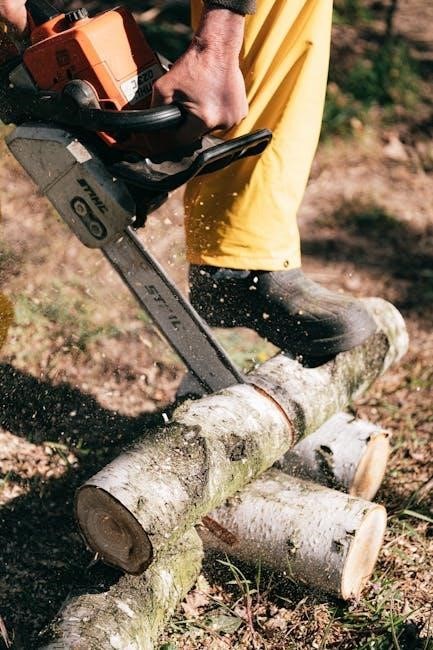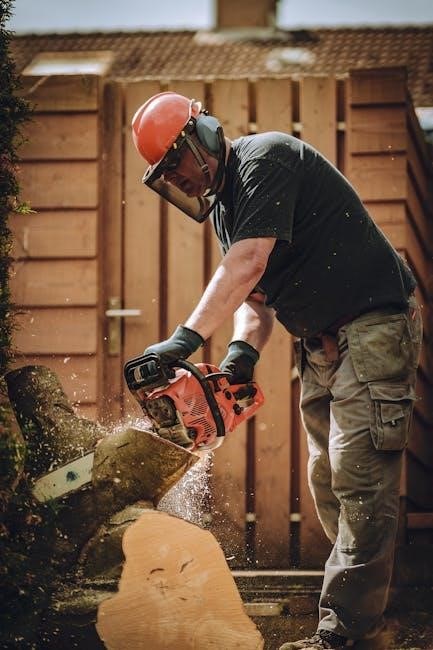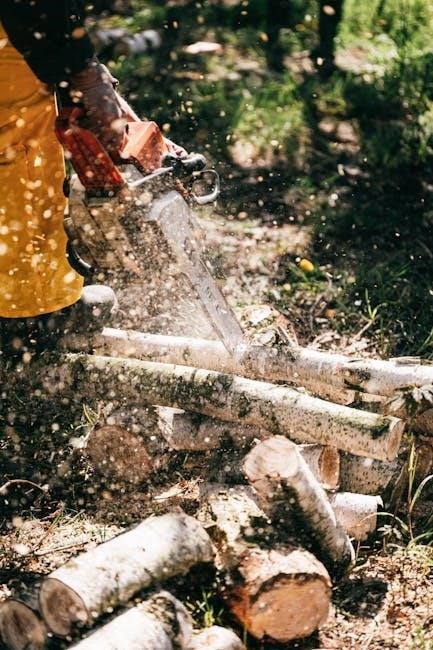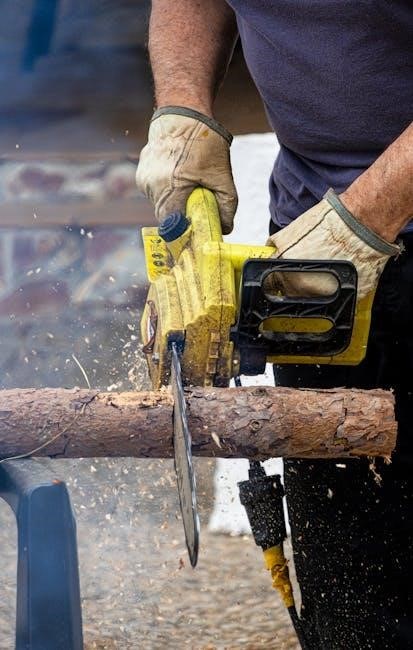A chainsaw manual is a comprehensive guide providing essential information on safe operation, maintenance, and troubleshooting. It ensures proper usage and maximizes efficiency while minimizing risks.
1.1 Importance of Reading the Manual
Reading the chainsaw manual is crucial for understanding safe operation, proper maintenance, and troubleshooting. It provides essential safety precautions, explains key components, and guides users on how to handle the tool effectively. Adhering to the manual reduces accident risks, ensures optimal performance, and extends the chainsaw’s lifespan. It also helps users comply with manufacturer recommendations and legal requirements, making it a vital resource for both beginners and experienced operators.
1.2 Key Components of a Chainsaw Manual
A chainsaw manual typically includes safety guidelines, assembly instructions, operating procedures, and maintenance tips. It outlines key features, troubleshooting steps, and warranty information. The manual also covers proper chain sharpening, bar maintenance, and storage methods. Understanding these components ensures safe and effective use of the chainsaw, making the manual an essential resource for users.

Safety Precautions and Guidelines
Safety is paramount when operating a chainsaw. Always wear protective gear, ensure proper footing, and follow manual instructions to minimize risks and prevent accidents effectively.
2.1 General Safety Rules
Always ensure a secure grip and stable footing before operating. Avoid cutting above shoulder height and never use the saw near flammable materials. Keep loose clothing tied back and maintain a clear work area. Properly assemble the chainsaw as per the manual to prevent accidental starts. Never leave the saw unattended while running, and keep bystanders at a safe distance to avoid injury from debris or kickback.
2.2 Personal Protective Equipment (PPE)
Wear appropriate PPE, including safety glasses, ear protection, gloves, and sturdy boots. Use chainsaw chaps or leg protection to guard against cuts. A helmet with a face shield is recommended for added safety. Ensure all gear fits properly and meets safety standards to provide optimal protection during operation.
Understanding Chainsaw Components
A chainsaw consists of key parts like the engine, bar, chain, and controls. Each component plays a crucial role in its functionality and performance during cutting tasks.
3.1 Main Parts of the Chainsaw
A chainsaw typically consists of an engine, cutting bar, chain, throttle, choke, air filter, and spark plug. The engine powers the chain, which rotates along the bar to cut materials. The throttle controls speed, while the choke regulates airflow for starting. The air filter ensures clean air intake, and the spark plug ignites the fuel mixture. Understanding these components is crucial for proper operation and maintenance.
3.2 Chain and Bar Maintenance
Regular maintenance of the chain and bar is essential for optimal performance. Keep the chain sharp and properly tensioned to prevent wear. Lubricate the bar and chain frequently to reduce friction and extend lifespan. Clean debris from the bar groove and chain links to ensure smooth operation. Properly store the chain and bar when not in use to avoid rust and damage, ensuring reliability and safety during future tasks.

Starting and Stopping the Chainsaw
Ensure the chain brake is engaged and follow the manual’s starting procedure. Properly prime and choke the engine, then pull the starter cord firmly. To stop, disengage the throttle and allow the chain to idle before shutting off. Always monitor the chain during shutdown to prevent accidental movement.
4.1 Proper Starting Techniques
Ensure the chain brake is engaged and the chainsaw is on a flat, stable surface. Prime the engine by pressing the primer bulb 2-3 times. Engage the choke, then pull the starter cord firmly until the engine coughs. Release the choke and pull the cord again until the engine starts. Allow the saw to warm up before use. Always wear PPE and ensure the area is clear of obstacles.
4.2 Safe Shutdown Procedures
To safely shut down the chainsaw, stop the engine and allow it to cool. Engage the chain brake and ensure the chain stops moving. Turn off the ignition and remove the key if applicable. Store the saw in a secure, dry location. Always wear PPE and ensure the area is clear of hazards. Proper shutdown prevents accidental startups and ensures the saw remains in good working condition for future use.

Operating the Chainsaw
Operating a chainsaw requires proper posture, a firm grip, and control. Always maintain a stable stance and use both hands to handle the saw efficiently and safely.
5.1 Basic Cutting Techniques
Mastering basic cutting techniques ensures safe and efficient chainsaw operation. Maintain proper posture, grip the saw firmly with both hands, and keep the chain sharp. Apply steady, controlled pressure, and avoid cutting through twisted or bent materials. Use the saw’s weight to assist cutting, and never apply excessive force, which can lead to loss of control or accidents. Always follow the manual’s guidelines for optimal results.
5.2 Dealing with Kickback
Kickback is a major chainsaw hazard, occurring when the chain strikes an object unexpectedly. To minimize risk, maintain a sharp chain, use proper cutting techniques, and avoid over-reach. Wear protective gear, including a helmet and gloves. Stay alert and keep the saw at a safe distance from your body. Regularly inspect the chain and bar for damage, and ensure the chain brake is functioning correctly. Always follow the manual’s guidelines for safe operation.
Maintenance and Servicing
Regular maintenance is crucial for chainsaw performance and longevity. This includes chain sharpening, bar lubrication, and engine tuning to ensure optimal operation and safety standards.
6.1 Sharpening the Chain
Sharpening the chain is essential for maintaining cutting efficiency and safety. Use a file guide to ensure correct angles and uniform sharpening of cutters; Always sharpen in the same direction as the chain rotation. Check and adjust the depth gauges to prevent over-sharpening. Regular sharpening prevents wear and ensures smooth operation. Refer to the manual for specific techniques and tool recommendations to achieve optimal results and extend chain life.
6.2 Regular Maintenance Tasks
Regular maintenance is crucial for the longevity and performance of your chainsaw. Check and clean the air filter to ensure proper airflow. Lubricate the chain and bar regularly to reduce friction and wear. Inspect the chain for damage and tension it as needed. Drain old fuel and replace it with fresh, properly mixed fuel. Consult your manual for specific maintenance schedules and procedures to keep your chainsaw running efficiently and safely.

Troubleshooting Common Issues
Identify and resolve common chainsaw problems, such as poor cutting performance or engine issues, by checking chain tension, lubrication, and fuel quality. Address kickback and vibration promptly.
7.1 Diagnosing Chain Problems
Diagnosing chain issues begins with inspecting for wear, damage, or improper tension. A loose chain can cause inefficient cutting, while a tight one may lead to premature wear. Look for signs like uneven cutting, vibration, or smoke, which indicate a dull or misaligned chain. Regularly check for broken links and ensure proper lubrication to maintain optimal performance and safety.
7.2 Solving Engine-Related Issues
Engine problems often stem from issues like faulty spark plugs, clogged air filters, or improper fuel mixtures. Check the air filter and clean or replace it if dirty. Ensure the spark plug is in good condition and properly gapped. Verify the fuel mixture meets the manufacturer’s specifications. If issues persist, consult the manual or contact a certified technician for advanced troubleshooting and repairs.
Storage and Transportation
Store your chainsaw in a dry place, with the fuel tank drained and chain protected. Transport it in a secure, protective case to prevent damage or accidents.
8.1 Proper Storage Conditions
Store your chainsaw in a dry, well-ventilated area away from direct sunlight and moisture. Drain the fuel tank to prevent stale fuel and corrosion. Clean the chain and bar thoroughly before storage. Use a protective cover or case to shield the saw from dust and damage. Ensure the storage location is secure and out of reach of children. Always refer to the manual for specific storage recommendations.
8.2 Safety Tips for Transporting
Always transport the chainsaw with the chain covered and the saw turned off. Use a sturdy bag or case to prevent accidental damage. Ensure the fuel tank is empty or nearly empty to avoid leaks. Secure the saw firmly in the vehicle to prevent movement during transit. Never leave the chainsaw unattended in public areas. Follow local regulations for transporting power tools.

Advanced Techniques and Tips
This chapter covers advanced techniques and tips to enhance cutting efficiency and professional logging practices. Mastering these methods improves accuracy, productivity, and safety in challenging tasks.
9.1 Optimizing Cutting Efficiency
Optimizing cutting efficiency involves maintaining a well-sharpened chain, ensuring proper chain tension, and using the correct cutting angles. A sharp chain reduces effort and time, while proper tension prevents overheating. Using the right technique, such as maintaining consistent momentum and avoiding applying too much pressure, enhances performance. Regular maintenance and adhering to manufacturer guidelines further maximize efficiency, ensuring precise and effective cuts in various materials.
9.2 Professional Logging Practices
Professional logging practices emphasize safety, efficiency, and sustainability. Assessing the site, planning cuts, and using proper techniques minimize risks. Maintaining equipment and following manual guidelines ensures reliability. Sustainable practices, such as selective cutting and avoiding sensitive areas, protect the environment. Adhering to safety protocols and environmental regulations demonstrates professionalism and responsibility, ensuring efficient and ethical logging operations.